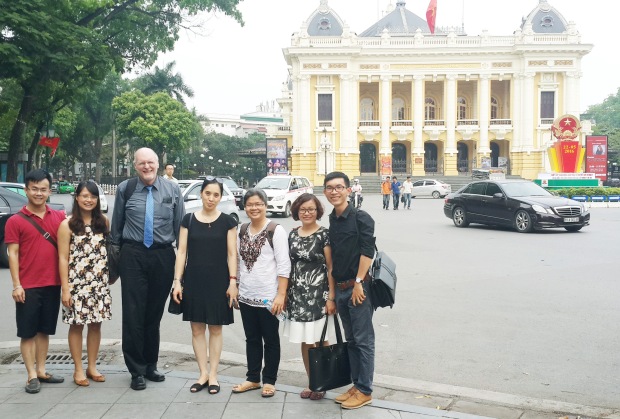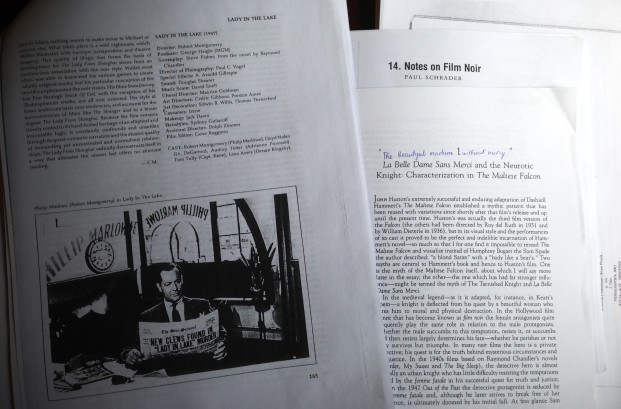From January to May 2016, teachers and graduate students at the University of Languages and International Studies converged in an American Studies class held by the Faculty of Linguistics and Cultures of English Speaking Countries.
Through this course, we have improved our understanding of two forms of American Arts, coming closer to the American culture. I relished being able to return to my school, seeing my former teachers, and seriously engaging in the United States Studies, which I had been doing individually since 2012. It was wonderful to study alongside my teachers and other professionals with much experience in the field.
Our course instructor, Professor Jack Yeager from Louisiana State University, is a Fulbright scholar and expert in Francophone literature. His Fulbright fellowship offered him the second chance to be in Vietnam; this time at my university for six months.

Professor Yeager delivered the course in two parts. Part One focused on American short narrative; the other on Film noir.
The first part commenced with two chapters of Mark Twain’s “Life on the Mississippi” (1883). Reading “Castles and Culture” and “The Metropolis of the South”, we journeyed back to the late 19th century Louisiana, particularly to two major cities – Baton Rouge and New Orleans. Twain’s vigorous language pioneered the “narrative journalism” and “travel writing”, transforming the Mississippi river from a transportation corridor into a “personality” and a quintessentially American soul.
The discussion locomotive marched on with Nathaniel Hawthorne’s “The Birthmark” (1843) and Edgar Allan Poe’s “The Tell-tale Heart” (1845) – two works of early American Romanticism. By the 1830s, European countries had been transitioning into literary Realism. Although flowering 30 years later than its European counterpart, American Romanticism shared the movement’s essential themes of human isolation, discontent with urbanism, and the fascination with the supernatural. Though regarded as masterworks, these narratives received critical questions about their limited white-male perspectives, their historical and socioeconomic context in which they were composed.
Afterwards, we studied the Naturalistic school exemplified with Stephen Crane’s “The Blue Hotel” (1899), Willa Cather’s “Two Friends” (1931), Jack London’s “To Build a Fire” (1908). These short stories explored the harsh nature of the Midwest (Nebraska, Kansas) and Yukon. Crane examined the immigration mindset and fatal miscommunication among people. Cather, infusing the Panic of 1893, the Gold Standard crisis and the 1896 Presidential election in her story, proved that the political atmosphere in America at the time was far-reaching and potentially divisive. Jack London vividly portrayed man’s futile conquest against nature and the unknown.
The three above stories are coated with regional dialects, historical allusions, and unusual punctuation. Thus, often we must read their dialogues aloud to understand the mood and to process comprehension. The class encountered this similar issue with O’Henry’s “The Gift of the Magi” (1905), a parable rich in comic irony, slang, and rhythm.
In addition, we studied a young voice from the Vietnamese American community, with Monique Truong’s comic tale named “Skin and Bones” (2014). Written about a Vietnamese American woman’ journey to Vietnam to learn about her origin, its fantastical nature resembles that in Maxine Hong Kingston’s novel “The Woman Warrior” (1976) which concerns majorly about the Asian American experience.
Also interested in gender studies, professor Yeager brought to class early American stories that reflect gender attitude across the centuries. For instance, Kate Chopin’s “Desireé Baby” (1893) and William Faulkner’s “Dry September” (1931) – two stories that raised debates about feminism, class, and race (especially in the American South). “Brokeback Mountain” (1997) by Annie Proulx explores the taboo subject of homosexuality in the unforgiving landscape of Wyoming, western America.
The question of racism and justice was put into perspective at our screening of “To Kill a Mocking Bird” (Universal Pictures, 1962), an Oscar-winning film based on Harper Lee’s Pulitzer-Prize winning novel of the same name. Often invigorated with professor Yeager’s American experience and perspective, the Q&A sessions gave us a more wholesome picture of the United States history, landscape, and people.
There are legitimate questions to ponder, moreover. The purpose of this introductory course was to provide an overview and the techniques to integrate some of the course materials into the faculty’s literature syllabus and teaching methodology. “Should and how do we insert a particular narrative into the class discussion?” “Is it too long or too short for the task at hand?”, “How can we make it attractive to the students?”, “What background information do the students need?”, “Should films be a medium for teaching in a literature classroom?” So on.
Taking the opportunity to prepare and present the assigned stories, we marched into the rigorous classroom discussion. But for the limited time budget, I wish there were Mid-term/Final essays or Reaction papers as in the intended syllabus. Plus, it is fun to do a reading collage, a writing portfolio, or short “report” videos for the future workshops.
————
The second half of the course focused on American Film Noir – a famous Hollywood film genre/style.

Influenced by German Expressionist cinema and film directors who fled Germany during World War II, Film noir borrowed many German aesthetic devices, plot conventions, and stereotypical characters, to evolve into a wholly American film style.
Detective fiction of the early 20th century inspired Film noir, whose plots frequently concern crime, deadly violence, daring “mind game” between ambitious criminals and clever detectives. The setting is usually the city at night with criminal activities and gunfights.
It is difficult to define Film noir, however. Not every film noir has a private detective and a killer dame (“femme fatale”) set in an urban landscape. One film can be more brutal, explicit, or romantic than the other. There is so much to learn that a few class sessions (despite extensive discussion) seemed to scratch merely on the surface.
The chosen classic films were The Maltese Falcon (Warner Brothers, 1941), M (Nero-film A.G., 1931), The Big Sleep (Warner Brothers, 1946), The Big Heat (Columbia, 1953). During the screenings, we paused at key scenes to discuss the technical innovations, i.e. the high-speed lenses, the angled shots and close-up shots, dark/light contrast, the classic three-point lighting, etc.
There were difficulties since the characters spoke in the old vernacular (although the films did have subtitles). Certain scenes carry symbolic meaning or reference to contemporary people’s attitudes. For example, the dark streets, the shadows, the stairs, the bridges. That is not to mention the symbolic costume, makeup, and hairstyles.
For me, the course has been highly educational, although film noir is not my favorite film genre. The wonderful part is to be able to recognize the “noir” techniques and motifs that are still widely employed in modern films. It’s amazing how those little things can create such nuanced psychological effects in film viewers.
—————
Thank you the Faculty of Linguistics and Cultures of English Speaking Countries for successfully holding this course, for sharing your concerns about the school, the curriculum, the students, and most of all, your life as a teacher. We express our special thanks to professor Yeager, for his commitment, his knowledge and witty sense of humor. Thanks for making this learning experience much more fruitful than it would have been had we done it alone. We hope to meet again in the future!






I am envious!! I would LOVE to take a course like this!!
LikeLike
Thank you, Tom! I wish the course had time for essays because I’d love to write and get comments. What aspects of the course would you feel most interested in?
LikeLike